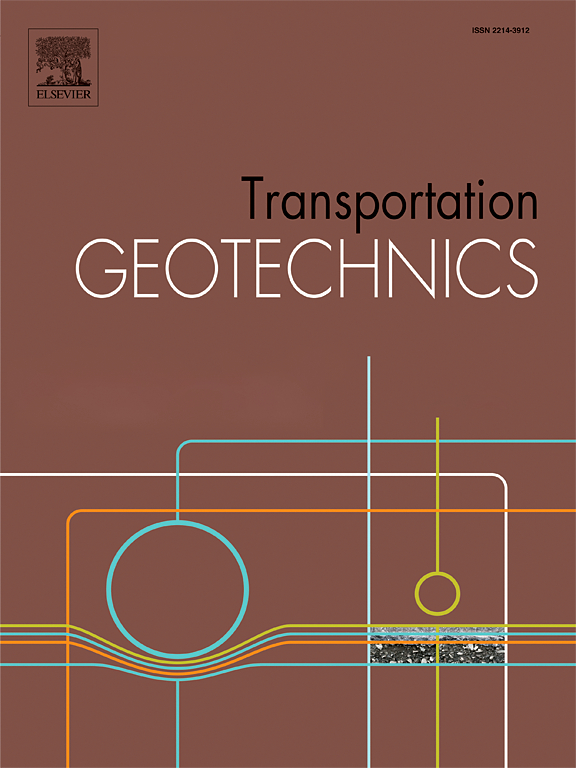Vibratory probe compaction of recycled concrete aggregates: Unveiling force and energy transfer mechanisms with particle redistribution
IF 4.9
2区 工程技术
Q1 ENGINEERING, CIVIL
引用次数: 0
Abstract
The global rise in construction waste has increased the use of recycled concrete aggregates (RCA), which show potential as fill materials in geotechnical engineering despite weak mechanical properties due to cement mortar coatings. This study examines the effectiveness of vibratory probe compaction in enhancing RCA properties through model tests. Optimal compaction parameters, including a frequency of 11.2 Hz and duration of 80 s, were determined. Vibration and soil pressure sensors revealed energy transfer concentrated near the probe tip, significantly increasing horizontal stress, particularly in deeper layers, where it rose up to eightfold. Light-weight dynamic cone penetrometer tests showed a 3–6 fold increase in blow counts, correlating with a 19.7 % density improvement. Gradation analysis indicated particle segregation, with smaller particles settling downward and larger ones moving upward, though minimal global breakage occurred. Extra fines are observed at the base produced from mortar abrasion which in turn, allowed the enhancement of intergranular contact development, therefore improving overall stiffness and strength. These findings confirm that vibratory probe compaction effectively improves RCA's mechanical properties, demonstrating strong potential for practical engineering applications.
再生混凝土集料的振动探针压实:揭示力和能量传递机制与颗粒重分布
全球建筑垃圾的增加增加了再生混凝土骨料(RCA)的使用,尽管由于水泥砂浆涂层的机械性能较弱,但它在岩土工程中显示出作为填充材料的潜力。本研究通过模型试验检验了振动探针压实在提高RCA性能方面的有效性。确定了最佳压实参数,包括频率为11.2 Hz,持续时间为80 s。振动和土壤压力传感器显示,能量传递集中在探针尖端附近,显著增加了水平应力,特别是在较深的地层中,水平应力增加了8倍。轻型动态锥形穿透计测试显示,打击次数增加了3-6倍,与19.7%的密度改善相关。级配分析表明颗粒偏析,较小的颗粒向下沉降,较大的颗粒向上移动,但总体破碎程度最低。在砂浆磨损产生的基础处观察到额外的细粒,这反过来又增强了晶间接触的发展,从而提高了整体刚度和强度。这些研究结果证实,振动探针压实有效地改善了RCA的力学性能,显示出实际工程应用的强大潜力。
本文章由计算机程序翻译,如有差异,请以英文原文为准。
求助全文
约1分钟内获得全文
求助全文
来源期刊

Transportation Geotechnics
Social Sciences-Transportation
CiteScore
8.10
自引率
11.30%
发文量
194
审稿时长
51 days
期刊介绍:
Transportation Geotechnics is a journal dedicated to publishing high-quality, theoretical, and applied papers that cover all facets of geotechnics for transportation infrastructure such as roads, highways, railways, underground railways, airfields, and waterways. The journal places a special emphasis on case studies that present original work relevant to the sustainable construction of transportation infrastructure. The scope of topics it addresses includes the geotechnical properties of geomaterials for sustainable and rational design and construction, the behavior of compacted and stabilized geomaterials, the use of geosynthetics and reinforcement in constructed layers and interlayers, ground improvement and slope stability for transportation infrastructures, compaction technology and management, maintenance technology, the impact of climate, embankments for highways and high-speed trains, transition zones, dredging, underwater geotechnics for infrastructure purposes, and the modeling of multi-layered structures and supporting ground under dynamic and repeated loads.
 求助内容:
求助内容: 应助结果提醒方式:
应助结果提醒方式:


